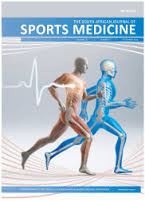The physical attributes of sub-elite rugby union referees of inland provinces in South Africa
DOI:
https://doi.org/10.17159/2078-516X/2021/v33i1a8835Abstract
Background: The purpose of the on-field referee is to implement the laws of the game. For the referee to do this successfully, he is required to keep up with the pace of play. Objectives: The aim of this study was to determine the physical attributes of sub-elite rugby union referees of inland provinces in South Africa.
Methods: A total of 82 referees (age: 26.5 ± 6.4 years; stature: 177.3 ± 6.8 cm; body mass: 79.1 ± 14.7 kg) were assessed with a reliable testing battery.
Results: The participants showed a refined aerobic capacity (VO2max: 61.8 ± 11.0 mL·min-1·kg-1) and good agility (Illinois Agility Test: 17.2 ± 3.8 s). A two-way unbalanced ANOVA was performed for all referees’ attributes between qualification levels (levels 1-4) and union affiliations (three unions) at a significance level of p<0.05. The results yielded significant differences across the three unions in age (p=0.002), Yo-Yo distance (p=0.0001), aerobic capacity (p=0.0001), plank time (p=0.0001) and agility (p=0.027). Similarly, differences were reported across the four qualifications in aerobic capacity (p=0.0001) and agility (p=0.037).
Conclusion: These differences may be due to the diverse training programmes offered by the various unions. Additionally, an increased level of physical fitness may occur when progressing up the qualification levels.
Downloads
Downloads
Published
Issue
Section
License
The South African Journal of Sports Medicine reserves copyright of the material published. The work is licensed under a Creative Commons Attribution 4.0 (CC BY 4.0) International License. Material submitted for publication in the South African Journal of Sports Medicine is accepted provided it has not been published elsewhere. The South African Journal of Sports Medicine does not hold itself responsible for statements made by the authors.
How to Cite
- Abstract 430
- PDF 479





.png)